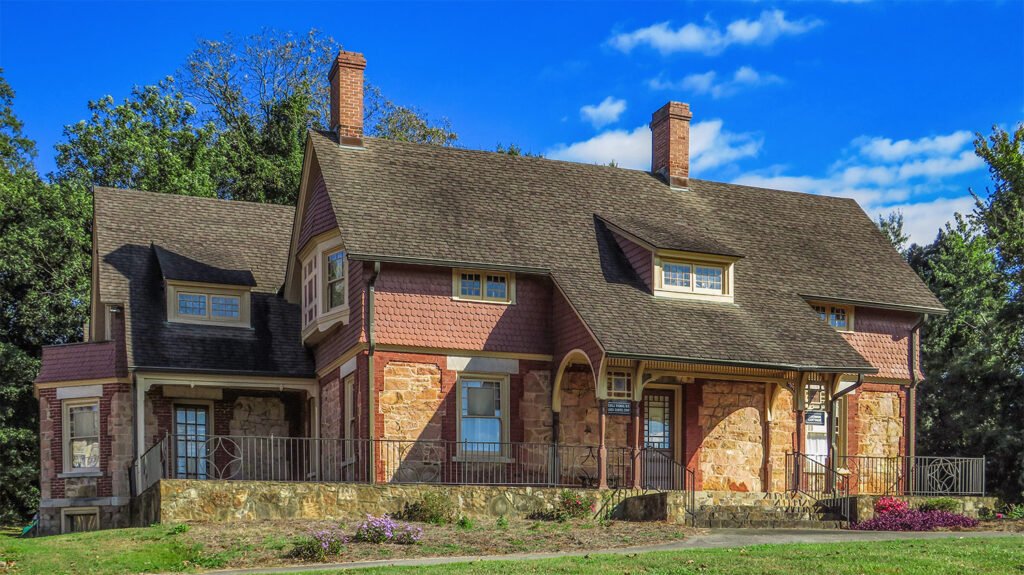
Lorenzo B. Wheeler (1854-1899), professionally known as L.B. Wheeler, was an architect who practiced in Atlanta from 1883 to 1890. Of his many projects in Atlanta, only his interior design work for the Edward C. Peters House (1883)1 2 may still survive, although it’s unclear how much of that can be credited to him and not the home’s architect, G.L. Norrman.
Wheeler came to Atlanta from New York in 1883 to design the Kimball House Hotel,3 the first atrium hotel in the city and possibly the United States (no, Atlanta, it wasn’t the Hyatt Regency).

Before his time in the Southeast, Wheeler worked with Hugh Lamb from 1877-1881, and a handful of buildings by Lamb & Wheeler still survive in New York.
In Atlanta, Wheeler first partnered with H.I. Kimball,4 owner of the Kimball House, a prototypical Atlanta huckster who marketed himself as an architect and engineer — he was neither.
Wheeler was the first Atlanta architect to specialize in interior design. In the 1880s, much of his work involved decorating Peachtree Street mansions, including many designed by other architects. In 1885 and 1886, he wrote a series of articles on home decoration for The Atlanta Constitution, which will be published here soon.
In 1885, Kimball & Wheeler partnered with W.H. Parkins, Atlanta’s first legitimate architect.5 One surviving work from the Kimball, Wheeler & Parkins firm remains: the Randolph County Courthouse (1886) in Cuthbert, Georgia, primarily credited to Parkins.6
Kimball left the firm in 18867, and Parkins & Wheeler were associated for a brief period between 1886 and 1887,8 with one project from the firm surviving: the Oglethorpe County Courthouse (1887) in Lexington, Georgia, also credited to Parkins.9
Wheeler practiced independently from 1887 to 1890, and while he wasn’t an exceptional designer, his work was a little more skillful and interesting than most Atlanta architects of the era. His designs demonstrated an understanding of national architectural trends, and it appears he was particularly influenced by the work of H.H. Richardson.
In the late 1880s, Wheeler secured extensive work in several Alabama boomtowns, and 2 homes in Anniston, Alabama, are the only known extant works from his solo period.
Crowan Cottage10 (1886, pictured above) and Noble Cottage (1887, pictured below) are a pair of picturesque Queen Anne-style residences designed for Samuel Noble. Despite the homes’ nearly identical designs, Crowan Cottage has been ludicrously attributed to Stanford White,11 who never designed a damn thing in the Southeast.

Wheeler quickly fell out of favor with Atlanta’s ever-fickle elite, and in 1890, he relocated to Memphis, Tennessee, after securing the commission for the Cossitt Library 12 13(1893, demolished 1958), a beautiful Romanesque creation that could easily be considered his finest work.

Wheeler moved to St. Louis in the 1890s, where he worked in 2 different partnerships14 15before seemingly disappearing from the public eye by 1898. Following a brief illness, he died at his father’s home in Connecticut at the age of 45,16 with his death barely noted in newspapers outside of Atlanta.
Described as “quiet and reserved”, Wheeler reportedly owned many “rare and very expensive” books, with his library said to be “the finest collection of architectural works in the South.” After his death, The Atlanta Constitution claimed:
“His room at the Kimball contained only two chairs, his bed and a dresser, but it was so crowded with books that one experienced difficulty in moving about.”17
It somehow seems fitting that so few traces of Wheeler’s work remain.
- “Some New Buildings”. The Atlanta Constitution, July 12, 1885, p. 9. ↩︎
- “Southern Architecture”. The Atlanta Journal, January 1, 1886, p. 1. ↩︎
- “Mr. Kimball’s Projected Suburb”. The Atlanta Constitution, October 21, 1883, p. 8. ↩︎
- ibid. ↩︎
- “A Card.” The Atlanta Constitution, March 19, 1885, p. 5. ↩︎
- “Personal.” The Atlanta Journal, March 18, 1886, p. 4. ↩︎
- “Notice.” The Atlanta Constitution, July 1, 1886, p. 8. ↩︎
- “Notice of Dissolution.” The Atlanta Constitution, April 1, 1887, p. 5. ↩︎
- “Personal.” The Atlanta Journal, March 18, 1886, p. 4. ↩︎
- National Register of Historic Places Inventory – Nomination Form – Noble Cottage ↩︎
- National Register of Historic Places Inventory – Nomination Form – Crowan Cottage ↩︎
- “To Begin Work.” The Memphis Daily Commercial, April 6, 1890, p. 5. ↩︎
- “Another Big Building.” Memphis Avalanche, September 13, 1890, p. 1. ↩︎
- “Dissolution Notices”. St. Louis Daily Globe-Democrat, October 2, 1894, p. 7. ↩︎
- “The Holland Building.” St. Louis Daily Globe-Democrat, February 9, 1896, p. 30. ↩︎
- “Death of Mr. L.B. Wheeler”. The Atlanta Constitution, March 7, 1899, p. 2. ↩︎
- ibid. ↩︎